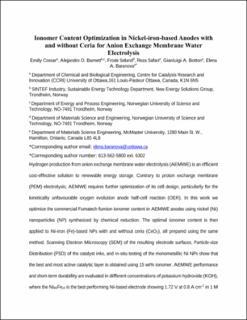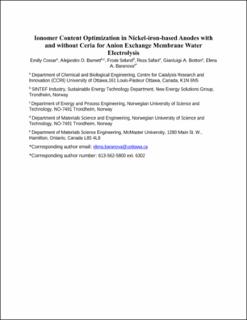| dc.contributor.author | Cossar, Emily | |
| dc.contributor.author | Barnett, Alejandro Oyarce | |
| dc.contributor.author | Seland, Frode | |
| dc.contributor.author | Safari, Reza | |
| dc.contributor.author | Botton, Gianluigi A. | |
| dc.contributor.author | Baranova, Elena A. | |
| dc.date.accessioned | 2022-04-29T09:17:02Z | |
| dc.date.available | 2022-04-29T09:17:02Z | |
| dc.date.created | 2021-10-25T14:11:56Z | |
| dc.date.issued | 2021 | |
| dc.identifier.citation | Journal of Power Sources. 2021, 514, 230563, 12. | en_US |
| dc.identifier.issn | 0378-7753 | |
| dc.identifier.uri | https://hdl.handle.net/11250/2993363 | |
| dc.description.abstract | Hydrogen production from anion exchange membrane water electrolysis (AEMWE) is an efficient cost-effective solution to renewable energy storage. Contrary to proton exchange membrane (PEM) electrolysis, AEMWE requires further optimization of its cell design, particularly for the kinetically unfavourable oxygen evolution anode half-cell reaction (OER). In this work we optimize the commercial Fumatech fumion ionomer content in AEMWE anodes using nickel (Ni) nanoparticles (NP) synthesized by chemical reduction. The optimal ionomer content is then applied to Ni-iron (Fe)-based NPs with and without ceria (CeO2), all prepared using the same method. Scanning Electron Microscopy (SEM) of the resulting electrode surfaces, Particle-size Distribution (PSD) of the catalyst inks, and in-situ testing of the monometallic Ni NPs show that the best and most active catalytic layer is obtained using 15 wt% ionomer. AEMWE performance and short-term durability are evaluated in different concentrations of potassium hydroxide (KOH), where the Ni90Fe10 is the best performing Ni-based electrode showing 1.72 V at 0.8 A cm−2 in 1 M KOH after IR-correction, and a degradation rate of 3.3 mV h−1. The addition of ceria to the Ni-based catalysts shows more consistent mass transfer over time likely due to more efficient water transport and bubble release. | en_US |
| dc.language.iso | eng | en_US |
| dc.publisher | Elsevier | en_US |
| dc.rights | Attribution-NonCommercial-NoDerivatives 4.0 Internasjonal | * |
| dc.rights.uri | http://creativecommons.org/licenses/by-nc-nd/4.0/deed.no | * |
| dc.subject | Ionomer optimization | en_US |
| dc.subject | Anion exchange membrane water electrolysis | en_US |
| dc.subject | Oxygen evolution reaction | en_US |
| dc.subject | Ceria | en_US |
| dc.subject | Iron | en_US |
| dc.subject | Nickel | en_US |
| dc.title | Ionomer content optimization in nickel-iron-based anodes with and without ceria for anion exchange membrane water electrolysis | en_US |
| dc.type | Peer reviewed | en_US |
| dc.type | Journal article | en_US |
| dc.description.version | acceptedVersion | en_US |
| dc.rights.holder | This is the authors’ accepted and refereed manuscript to the article. This manuscript version is made available under the CC-BY-NC-ND 4.0 license | en_US |
| dc.source.pagenumber | 12 | en_US |
| dc.source.volume | 514 | en_US |
| dc.source.journal | Journal of Power Sources | en_US |
| dc.identifier.doi | 10.1016/j.jpowsour.2021.230563 | |
| dc.identifier.cristin | 1948290 | |
| dc.relation.project | Norges forskningsråd: 261620 | en_US |
| dc.source.articlenumber | 230563 | en_US |
| cristin.ispublished | true | |
| cristin.fulltext | postprint | |
| cristin.fulltext | postprint | |
| cristin.qualitycode | 1 | |


